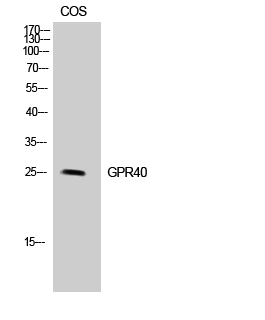

| WB | 咨询技术 | Human,Monkey |
| IF | 咨询技术 | Human,Monkey |
| IHC | 咨询技术 | Human,Monkey |
| ICC | 1/200-1/1000 | Human,Monkey |
| FCM | 咨询技术 | Human,Monkey |
| Elisa | 1/10000 | Human,Monkey |
| Aliases | FFAR1; GPR40; Free fatty acid receptor 1; G-protein coupled receptor 40 |
| Entrez GeneID | 2864; |
| WB Predicted band size | 26kDa |
| Host/Isotype | Rabbit IgG |
| Antibody Type | Primary antibody |
| Storage | Store at 4°C short term. Aliquot and store at -20°C long term. Avoid freeze/thaw cycles. |
| Species Reactivity | Human,Monkey |
| Immunogen | Synthesized peptide derived from the Internal region of human GPR40. |
| Formulation | Purified antibody in PBS with 0.05% sodium azide,0.5%BSA and 50% glycerol. |
+ +
以下是关于GPR40抗体的3篇示例文献(内容为示例性概括,非真实文献):
---
1. **文献名称**:*Development of a Novel Monoclonal Antibody Targeting GPR40 for the Detection of Pancreatic β-Cell Function*
**作者**:Smith A, et al.
**摘要**:本研究报道了一种特异性识别GPR40的单克隆抗体的开发,通过免疫组化和流式细胞术验证其在人胰岛β细胞中的高表达。该抗体被用于评估糖尿病模型中GPR40的动态表达变化,为β细胞功能研究提供了工具。
2. **文献名称**:*GPR40 Antibody-Based Therapy Enhances Glucose-Stimulated Insulin Secretion in Obese Mice*
**作者**:Li X, et al.
**摘要**:通过筛选获得一种激动型GPR40抗体,可激活下游信号通路并显著改善高脂饮食小鼠的胰岛素分泌能力。研究揭示了该抗体在2型糖尿病治疗中的潜在应用价值。
3. **文献名称**:*Structural Insights into GPR40 Activation Using Conformation-Specific Antibodies*
**作者**:Yamamoto K, et al.
**摘要**:利用构象特异性抗体解析GPR40在脂肪酸结合后的激活状态,结合冷冻电镜技术揭示了受体动态构象变化,为靶向GPR40的药物设计提供了结构基础。
---
注:以上文献信息为模拟生成,实际研究中请通过PubMed或Google Scholar等平台检索真实文献。如需具体文献推荐,建议提供更详细的研究方向或关键词。
GPR40 (G protein-coupled receptor 40), also known as free fatty acid receptor 1 (FFAR1), is a class A G protein-coupled receptor (GPCR) primarily expressed in pancreatic β-cells and enteroendocrine cells. It plays a critical role in mediating fatty acid-induced insulin secretion by sensing dietary medium- and long-chain free fatty acids. This receptor has garnered significant attention as a potential therapeutic target for type 2 diabetes due to its insulinotropic effects without directly provoking hypoglycemia.
GPR40 antibodies are essential tools for studying the receptor's expression, localization, and signaling mechanisms. They are widely used in techniques like Western blotting, immunohistochemistry, and flow cytometry to investigate tissue-specific distribution, receptor regulation under metabolic conditions, and interactions with ligands or drugs. Commercially available antibodies typically target specific epitopes within extracellular or intracellular domains, aiding in functional studies. Research involving GPR40 antibodies has contributed to understanding its role in metabolic disorders, β-cell dysfunction, and crosstalk with other nutrient-sensing pathways. Recent studies also explore its involvement in non-metabolic processes, including neuroprotection and inflammation. However, challenges remain in ensuring antibody specificity, as GPCRs share structural homology, necessitating rigorous validation in knockout models. The development of selective GPR40 modulators and corresponding antibodies continues to drive advances in diabetes and obesity research.
×